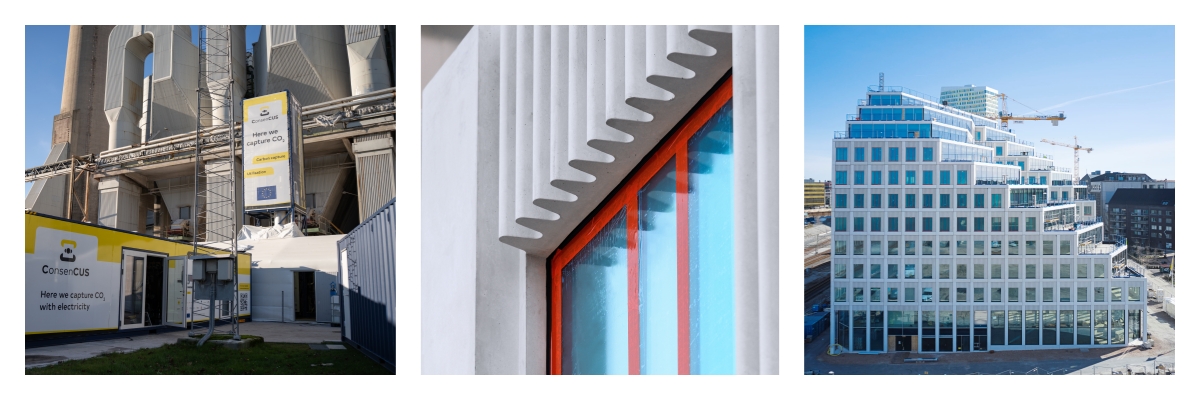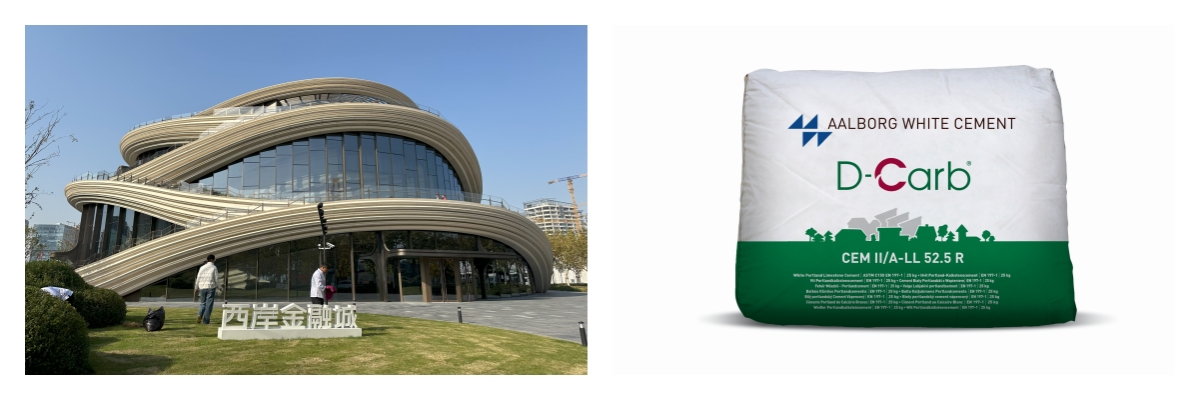Michele Di Marino, Stefano Zampaletta and Frank Brandt, Cementir Group, discuss how to decarbonise white cement while securing superior performance
Over the past few years, Cementir Group has undertaken a resolute commitment to address the pressing challenges posed by environmental issues and climate change. This commitment is reflected in its multifaceted approach, targeting the reduction of CO2 emissions and water consumption, preservation of natural habitats, and the promotion of technical solutions to minimise environmental risks. Cementir Group’s dedication to a low-carbon economy has earned accolades from CDP, an independent organisation, and a benchmark for environmental reporting.
In December 2022, Cementir Group achieved an ‘A’ rating for the second consecutive year in the Climate Change category, surpassing sector averages (B) and European averages (B). Simultaneously, its leadership position in CDP Water Security, with an ‘A’ score, has been confirmed. For the first year, Cementir has also been recognised Supplier Engagement Leader by CDP, positioning itself among the top 8% overall companies globally assessed for Supplier Engagement on climate change. The recognition as a Supplier Engagement Leader underlines, once again, its commitment to environmental stewardship. Even in 2023 Cementir submitted the CDP Questionnaires (Climate Change and Water Security) and as of January 2024 it is still under evaluation, awaiting the official 2023 rating.
In July 2021, the group’s CO2 emission reduction targets were validated from the Science-Based Targets initiative (SBTi), aligning them with the ambitious ‘well below 2°C’ objective outlined in the 2015 Paris Climate Agreement.
In 2023, following the formalisation of the guidelines for the cement sector by SBTi, Cementir updated its transition plan and filed a commitment to be aligned to 1.5°C SBTi scenario. As of January 2024, the validation process from SBTi is still in progress.
The efforts to diminish environmental impact cover the entire value chain, from procurement and manufacturing to logistics and distribution. Cementir Group actively collaborates with local communities, suppliers, customers, non- governmental organisations, and various stakeholders. Through a comprehensive 10-year roadmap, Cementir Group aims to implement more disruptive measures to combat climate change, emphasising the maximisation of existing technologies and the groundwork for breakthrough innovations leading to the production of ‘net-zero emissions’ cement.
Image (left): Pilot CCS unit installation underway at Aalborg Portland(Cementir Subsidiary), with ongoing feasibility studies at seleted plants.
Image (Middle & Right): Hyllie Terrass, a climate neutral building in white concrete. Façade claddings produced by UPB Group based on Aalborg White cement.
From 2022, the group has intensified its focus on innovation, a fundamental driver for sustainable progress. Ongoing studies and the development of low-carbon cement were completed and the installation of a pilot carbon capture and storage (CCS) unit at Aalborg Portland has started with additional feasibility studies of CCS technologies at selected plants. Consequently, the 2030 Roadmap underwent updates to include the deployment of carbon capture technologies at the Aalborg plant, in addition to actions already planned for all its operations. The CCS test facility is part of the ConsenCUS project, consisting of several leading research institutions and companies, and funded by the European Union’s Horizon 2020 research and innovation programme.
White Cement Sustainability Transition
Cementir’s commitment to sustainability extends to its white cement production, where unique challenges arise. As the world’s leading producer and exporter of white cement with approx. 25% share of worldwide trade and a production capacity of over 3 million t, Cementir Group, through its renowned global brand Aalborg White®, has played a pivotal role in iconic structures worldwide, from the Kennedy Centre for the Performing Arts in Washington to the Naturalis Biodiversity Centre in Leiden, and from Azabudai Hills in Tokyo to the Mei Xi Hu International Culture and Art Centre in Changsha.
The distinct features of white cement, characterised by its colour and high performance, are achieved through the meticulous selection of highly pure and carefully chosen raw materials, complex production processes, and an exceptionally rigorous quality control process.
Transitioning towards more sustainable production in the white cement segment constitutes distinct challenges compared to grey cement, due to major differences in the production process and the high-quality standards required. Common actions to reduce carbon footprint, such as the use of alternative fuels and supplementary cementitious materials (SCM), face heightened challenges, particularly concerning the colour impact.
From a process perspective, the limited usage of alternative fuels due to their negative impact on colorimetric performances creates a main challenge. Cementir Group has partially mitigated this limitation for instance through the recovery of waste heat from the cement kilns in Aalborg, DK. The Aalborg plant recovers excess heat from cement production, providing district heating to approximately 30 000 local households. In 2022 alone, the Aalborg plant delivered approximately 1.3 million GJ of energy, equivalent to an estimated 150 000 t of CO2 not emitted from a local coal-fired power station.
On the product front, the currently used SCM to lower the clinker ratio in cement while preserving performance, poses challenges for white cement. Almost none of these materials can effectively replace white clinker without negatively impacting whiteness – the distinctive value proposition in comparison to grey cement. Therefore, the selection, availability, and quality consistency of materials become crucial in reducing the carbon footprint in white cement production.
Continuous and consistent decarbonisation
Addressing these challenges, Cementir introduces D-Carb, representing a continuous and consistent decarbonisation effort for the Aalborg White range. As a leader in white cement, Cementir has embraced the challenge of lowering cement’s carbon footprint within the constraints linked to colour and performance requirements. Leveraging long-term expertise in research and development and industrial production, a comprehensive investigation was carried out, starting from customer needs, and going upstream to the entire value chain, encompassing clinker and cement composition, production, and raw materials selection.
To provide customers with more than just a product, technical collaborations have been established with leading companies in the admixtures sector as well as with loyal customers to deep dive into several end-applications.
In order to meet the tight timing for more sustainable solutions, fast-prototyping techniques were deployed, involving extensive experimentation at lab and full-scale trial levels. This has allowed to turn a proven concept into an industrial reality: D-Carb family.
D-Carb is a new umbrella brand for white low-carbon cements, supporting industry-wide decarbonisation efforts. D-Carb will be firstly rolled-out in Europe and then in all the regions. The first product of its kind, a CEM II/A-LL 52.5R will be produced in Aalborg and set to be launched in April 2024 in bulk and bags, further expanding the product offerings in Europe. D-Carb matches a lower carbon footprint (-15% of emissions documented with Environmental Product Declaration by third party in this first product) with outstanding performances at early ages comparable to CEM I. Moreover, it offers improved rheology and whiteness in certain applications. The interaction between well-known Aalborg White® clinker and limestone has been optimised, leveraging in-house extended expertise in white cement.
This high-quality standard enables the group’s customers to consider replacing CEM I in their manufacturing processes after a specific testing programme. No incompatibility with admixtures has been experienced during the extensive experimental phase. Cementir Group will keep up its customer-centric approach with its technical experts equipped to guide customers in adopting this new product and integrating it into their production processes.
As part of Cementir Group’s overarching roadmap, ongoing evaluations are underway to strengthen the D-Carb offering within the low-carbon cement spectrum. Cementir Group is committed to leading the way in sustainable cement production, contributing to a greener future for the construction industry. Through innovation, collaboration, and a steadfast commitment to environmental stewardship, the company strives to redefine the possibilities of cement production, sounding the bell for an era of sustainability and resilience for generations to come.
Image (left) :Shanghai West Bund Orbit designed by Heatherwick studio, using Aalborg White cement based GRC Claddings.
Image (Right) : D-Carb in bulk and bags.